Unless you’re looking for it, the tech company formerly known as Enflick is easy to miss.
Recently rebranded as TextNow, the mobile startup is tucked inside the Cora Building in the David Johnston Research + Technology Park on the University of Waterloo’s north campus, a modern glass-and-steel structure it shares with Agfa HealthCare, Watsec Cyber Risk Management, Cisco and a few others.
Low-key as the company has been since Derek Ting and Jon Lerner co-founded it as UW students in 2009, TextNow saw 50-fold revenue growth in its first five years, doubled its headcount to 75 in the past year and now counts 50 million users of its low-cost mobile phone service, a number that continues to surge with each passing month.
In other words, it’s one of the biggest Waterloo tech successes you’ve never heard of – for the moment anyway.
With a scant $1.5 million in outside investment – a 2011 seed round whose participants included Justin Bieber’s and Lady Gaga’s managers – TextNow has achieved the kind of growth usually reserved for startups with far more venture backing.
All of it has happened under the quiet guidance of Ting, an unassuming computer engineer who built his first company at age 15, and is admired by other founders for his shrewd adherence to Lean startup principles.
“Derek is as product-market-fit-focused as they come,” Michael Litt, CEO of fast-growing Vidyard and a contemporary of Ting, told me this week. “There’s much I have and still can learn from D-Ting.”
Eager to know more, I trekked up to the R+T Park earlier this week to meet Ting in TextNow’s bright, recently expanded offices. Along with a kitchen and gym, its space includes a full-on distribution operation, where thousands of handsets are loaded with firmware, charged up and shipped within two days to customers all over the U.S.
Our conversation ranged widely, from the frustration of a Canadian startup being shut out of the domestic market by regulations that protect incumbents, to the importance of customer focus, to the folly of funding rounds being seen as a sole indicator of success.
Here’s how it went:
Q – Enflick is now called TextNow. Why the change?
A – When we first started the company, we didn’t have a product, so we gave it a name – Enflick – based on what we thought we were going to do.
We knew we wanted to do something in mobile, so the ‘En’ stood for engaging, and the ‘flick’ came from the flick gesture on your smartphone.
We started off wanting to employ ourselves instead of working for another company, so we built a bunch of prototypes before we figured out what we wanted to do.
Through the history of the company, we’ve done a bunch of things, and at some point we decided we wanted to focus on our app, TextNow. For a few years already, that’s been our main focus.
It’s natural to have that be the name of the company, to simplify our branding, to simplify our marketing and for recruiting. It’s kind of like the reason RIM changed to BlackBerry; RIM started out doing a bunch of different things and then they decided to focus on the BlackBerry.
We wanted our flagship product to be the name of the company, so that people know that when they’re working for us, they’re working on TextNow.
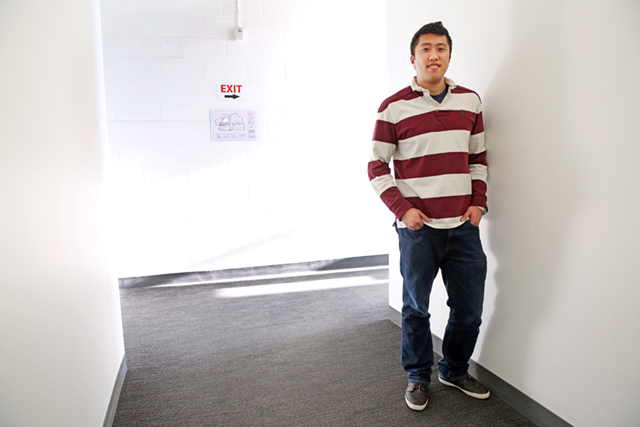
“We make a much better alternative to incumbent-carrier phone service.
That’s the one-sentence version.” – Derek Ting
(Communitech photo: Anthony Reinhart)
Q – If your neighbour asks you, ‘What does your company do,’ how do you answer in one sentence?
A – We make a much better alternative to incumbent-carrier phone service. That’s the one-sentence version.
Q – And invariably, the neighbour says, ‘Tell me more about that. Why is it better?’ And you say . . .
A – We aim to make it better in two ways.
One way is that we want to make it ultra-affordable. We have a version where you can actually get phone service for free. You can download our app onto any device that has Wi-Fi connectivity and turn it into a phone.
For example, we have a phone that doesn’t have service any more, or an iPad, or an iPod Touch. You can download our app, we give you a phone number, and with Wi-Fi, you instantly turn it into a phone with free texting and calling, and your own phone number.
Our app is in lieu of a SIM card. With Wi-Fi, you don’t need a SIM card.
The free model is advertising-supported, so with advertising, we’re able to give you essentially free wireless service over Wi-Fi.
And we’re the only solution out there that gives you your own phone number, unlimited texting in Canada and the U.S. for free, and calling in Canada and the U.S. for free. We also have a list of international destinations that you can call for free, to a landline.
There are solutions that have a portion of that, but we’re the only one that has all of this, in the market.
We have something you can upgrade to, as well, if you want something that replaces your phone service but you need to use it outside of Wi-Fi. Our free solution only works within Wi-Fi; otherwise you have to provide your own data connection.
We have a fully integrated solution where you can buy a handset from us, at really, really low cost. We have Android phones that start at $10; for example, the Moto E, and we have plans that start at $19 a month, still Internet-based, but that also work outside of Wi-Fi. We struck a partnership with Sprint to let our customers who are on that plan to use their network.
Q – Is that plan just in the U.S.?
A – It’s only available in the States right now, yes.
We’re trying to get it into Canada, but as you may know, the big three (incumbents) are doing everything they can to keep us out of the market.
It’s an important market for us, not from a numbers perspective, but from an emotional perspective. We still want to be here, to be home, but obviously from a numbers perspective it’s not as lucrative, and the walls are so much higher.
Q – Is this something the CRTC could change through regulation, to open up the field to you?
A – Actually, just a couple of weeks ago, they ruled against something like that.
The answer is yes, they can do something like that. A lot of other countries have done something about it.
For example, in Europe, a lot of countries realized they made a mistake in licensing or selling their spectrum to a few people, and they ended up with oligopolies that have made prices artificially really, really high.
They have implemented systems where they have mandated spectrum holders to share some of their spectrum with other companies, to create competition in the market.
In Europe, that’s very common – Spain, Germany, for example, have this kind of structure in place to promote innovation and competition in the marketplace, to counteract their mistake of giving spectrum to too few people.
Canada is one of those countries that sold spectrum to literally three players in the industry, and our politicians haven’t done anything about it.
That’s why our phone bills are super-high. Those big three will do everything they can to block us from getting into the market.
Our government could do something about it, but they chose not to. It’s unfortunate, because homegrown Canadian innovation is being artificially blocked.
Usually we have this mantra of ‘support Canadian, buy Canadian,’ but this is a case where we have something that’s homegrown, that’s built by Canadians, and our government is literally preventing us from selling it to our own.
It’s kind of ironic; we’ve been talking eliminating barriers for companies that export, but we’re creating this artificial barrier for a Canadian company to sell its own products and services within Canada, due to just really, really bizarre regulation.
Q – Not to mention the fact that your product appeals to people who can’t necessarily afford pricey mobile plans – people on limited incomes.
A – Yes. And we’ve had a lot of feedback from our customers saying, ‘Because of you, I can have this service.’
We don’t do credit checks. We do all the risky things that other telecom companies don’t. We have statistical models that allow us to be aggressive with giving them device subsidies and discounts.
That business model works, but it works because we’re not being conservative. We’re being aggressive in the marketplace. All of that benefits the consumer.
On top of the affordability part, we have a lot of innovation that incumbent phone companies don’t have. For example, you can use your phone number on more than one device, and you can use it on devices other than your phone. So, essentially, it becomes your number, not your phone number.
You can log in on a web browser, for example, and you can see all your message history, and you can actually text and make calls from your web browser without installing any software.
Let’s say you left your phone at home and went to work. It’s fine. I’ve done that before, and I just log in online, and instantly, I’m connected. People can still reach me on my number.
Or when your battery dies, for example. Or you just feel like using a bigger screen; you want to use your tablet. You can log in with our app and use the same phone number on any device you want because it’s cloud-based.
That’s kind of the tip of the iceberg of the innovation we offer to our customers, in terms of an enhanced wireless experience, that other operators just don’t feel like doing. They can do it, but they just don’t feel like doing it, because they’re already making lots of money.
And even if they do it, they do it as a way to nickel and dime you, whereas we just want to enhance the experience for our customers.
Those are the key differences between us, and it’s how we want to redo how companies provide wireless service to their customers.

Handsets undergo charging before being shipped to TextNow customers
all over the U.S. (Communitech photo: Anthony Reinhart)
Q – Does this ever create pressure to just move to the States?
A – The beauty is, we don’t need to be anywhere in particular to be able to sell globally. That’s one thing I’m really grateful for – borders have become less of a restriction to do business than they were before.
To give you some context on that, our entire customer care team is next door, and our e-commerce shipping and fulfilling operation is downstairs. So, every phone ordered from our website is shipped from Waterloo to all over the U.S.
We like the community here and we’ll do anything to support the community. As long as the economics work, we’re always going to be biased towards keeping everything local.
Q – Tell me more about your market.
A – Our market is pretty broad. It’s anyone who needs wireless service and doesn’t want it from an incumbent, and sees value in what we provide.
In terms of our focus right now, we’re focusing on youth in terms of our branding and who we appeal to, but in all honesty, the product is for everybody.
We even have a lot of seniors who chose us as their first smartphone.
We’ve designed it to be easy to use so that it can be for everybody.
Q – Michael Litt says you are “as product-market-fit focused as they come” and have managed to grow the way a venture-backed startup would, but without the venture backing. How have you done that?
A – I think really homing in on the MVP model, the Lean Startup model, is very important. That’s what allowed us to so quickly find our product-market fit.
There’s a degree of intuition as well, and intuition is just sometimes natural, and you can’t explain how you’re able to figure some things out that other companies may not be able to replicate.
But on that minimum viable product piece, as a company, we always try hard to maintain a discipline of not over-building something before we actually know that what we’re building is actually going to work.
I mentioned prototypes. We have an endless amount of ideas around businesses we want to build, and instead of just picking the one that appeals to our minds the most, we have a systematic process to figure out what it is that we want to focus on.
That process has to be quick and objective, so what we did was build prototypes that let us measure the market demand for the product without actually building the full-blown product. We had discipline to build the minimum viable product.
That doesn’t mean we build crap. It still has to be bug-free; it still has to work; it still has to have a good user experience. But it just means that we limit the scope of features so that the product can do exactly what it needs to do and solve the exact problem that it needs to solve.
Based on that, we looked at the traction and we looked at the potential market size, and decided to focus on the product that is TextNow.
It first started out at as a product that let you circumvent carriers and send messages for free over the IP network. Then it turned into this product where people use their iPod Touches to turn their iPod Touches into iPhones.
Then one step led to another in terms of us figuring out how to create more value for our customers. So, eventually we added calling, voicemail and stuff like that, and eventually it evolved into a product that fully replaced someone’s phone service, because we were seeing that our users were using our service for exactly that.
That’s how our product developed. We do really quick learning about the market and how our product plays a role in the market, and it’s that quick learning that helps us get there quickly.
That’s something that any company can use to really accelerate the finding of the product-market fit.
Q – Can you give me some key metrics about the company?
A – Our headcount has more than doubled over the past year, from 35 to 75 employees.
TextNow has more than 50 million registered users.
Our five-year revenue growth from 2009 to 2014 was 5,186 per cent.
Q – The company is how old now?
A – We incorporated in 2009 and we didn’t work on it full-time until September of 2009. That was our last co-op term in school.
And then in January to April 2010, we had to go back to school, and there was kind of a gap where we just kept the lights on and tried to hire employees, but we were juggling school and work at the same time.
Q – There’s an interesting story about that period that I seem to recall.
A – Do you mean when we were hiring interns while we were interns?
Apparently this didn’t happen a lot back then, but we were on our last co-op term, and instead of paying ourselves, we wanted to take all that money we were generating from our product and hire another co-op so that we could have maximum bandwidth to develop stuff.
So basically, when everyone in our class was interviewing for jobs, we were interviewing people to become our intern.
Apparently the school thought that was a potential problem. They didn’t find out until we were right in the middle of the interview process, but they were like, ‘Wait, wait, what’s happening?’
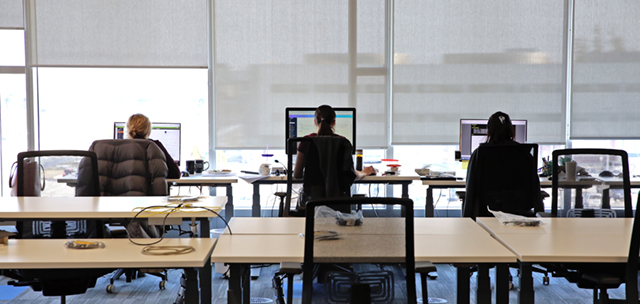
TextNow employees enjoy catered meals, an onsite gym and other perks
typical of high-growth startups in Waterloo.
(Communitech photo: Anthony Reinhart)
Their issue was that we’d be able to see grades and stuff for everyone who applied for our job; that students would see other students’ grades. But we talked to all the higher-up people at the school, and then we explained that we’re serious about what we’re doing, and this is not a random thing. And the school let us continue with it.
All they did was ask me and my co-founder to sign a non-disclosure agreement and that we’d keep everything to ourselves.
I think that’s one of the great things about the University of Waterloo. They understand that sometimes you’ve got to be pragmatic; otherwise you’re going to stop innovation. They weren’t like the typical school that says, ‘No, you can’t do that.’ We figured out a solution and made it work.
Q – This was before Velocity became what it is today, right?
A – Velocity was brand new at the time. I didn’t even hear about Velocity, even though I was there at the time. The year after, Velocity became popular, and that’s when a lot of startups started coming out of Velocity.
Q – So it was just you and your co-founder at the time?
A – Yes, Jon Lerner.
Q – Is he still here?
A – He took a step back from the day-to-day a couple of years ago, and he has trusted me to run the company, so that’s currently the way it is.
Q – Your LinkedIn profile includes a section about when you were 15, and you created a site to allow people to upload and share torrent files, as a summer vacation project that you eventually sold.
A – So, the crazy thing is, that site still has close to millions of unique users a month.
It’s called Torrent Reactor, and basically it’s a site where you do file sharing, like Napster. But it was using peer-to-peer technology called BitTorrent.
I started it when I was in high school, in my parents’ basement. It was pretty fun; I learned a lot. I learned how to run my own web servers. These hosting companies I was using kept shutting me down because I was using too much traffic, and eventually I had no option but to host it on my home Internet connection.
I had to build a Unix machine and host it on a home Internet connection, and the traffic became so much that it literally took down my home Internet all the time, and my parents couldn’t use it and got really frustrated with me.
I eventually had to put ads on my site and ask for donations and stuff, and I eventually moved it out of the basement and my parents could use the Internet again.
It got to the point where I was profiting because more people donated to me than it cost to run it, so that was pretty fun. I was living in Germany at the time with my parents, and I was kind of an expat, so I didn’t want to get into hot water or get deported. I wasn’t doing anything illegal, but I was facilitating illegal activity, so I sold the thing to a German guy.
Q – Did you do OK on the sale?
A – Honestly? I got ripped off. I had no negotiation skill back then; I didn’t know how much the thing was worth and I just wanted to get rid of it and focus on school.
I made a decent amount of money for a 15-year-old, but looking back on it now, I definitely did not maximize my value on that opportunity. But I learned a lot, and that money eventually went towards a car and my education, so it wasn’t that bad of a deal.
Eventually, I spun off a new business, because when I sold the site, I had a bunch of server leases that hadn’t expired yet, and I didn’t want to have the servers just sitting idle. So I was figuring out how I could rent them out, and I did.
I bought ads and, over a weekend, made a hosting company to lease out all the space. I made it look all professional and made people think it was real, and not a teenager in the basement.
Not only was I able to break even, but I made a profit. So I was like, ‘Why don’t I just repeat it and keep doing it and keep doing it?’ So that turned into another venture, where I basically became a web hosting company.
I outsourced the support for this company to India and automated almost everything. I still had to do the sys admin stuff, so when the servers would break, I had to fix it. Sometimes I’d be at school when they’d break and I had to run to the computer lab to fix them.
I grew to 500 customers, and I couldn’t really run it any more because I was doing the international baccalaureate program, and it was really demanding, so I wound down the business slowly. I tried to sell it, but then during the process of selling it to someone, PayPal wouldn’t let me transfer a Canadian PayPal account to a U.S. one, and the deal fell through. So I ended up just winding down the rest of the thing.
When all was said and done, it paid for a chunk of my college education and I bought a car with it. So that’s the background of what I did before university.
Q – You didn’t study how to run a business, but just figured it out yourself?
A – Yes. Some of it was instinct; I kind of just knew how to make a profit.
The other motivation at the time was, I wasn’t able to get a part-time job, because my parents were living in Germany and I would have needed a visa to work in Germany.
In a way that was good, because it forced me to come up with alternative solutions to make my own discretionary income.
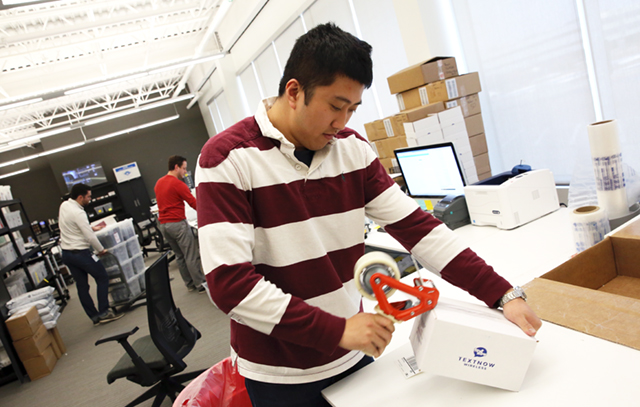
Derek Ting boxes a handset for shipping to Texas moments after a
customer placed the order. (Communitech photo: Anthony Reinhart)
Q – Did you grow up in Canada?
A – I was born in Hong Kong, but my mom and I moved here when I was seven, and I grew up in London, Ontario. Then my mom remarried to a German guy and we moved to Germany when I was 14.
Then I came back after I graduated, and they still live there.
Then, because I started a company here (in university), I stayed, while the rest of my class went to Silicon Valley.
Q – Why did you decide to stay when all your classmates were going to the Valley?
A – It wasn’t really a conscious decision, honestly. I’ll tell you the truth: I wasn’t looking at the map and deciding Waterloo was it. It was just kind of the most convenient place at the time to start a business, because I was here and I had no strong reason to go. A bunch of people were here helping me build my business, so why would I move?
Q – Did you go to school here with others who have gone on to become startup founders?
A – Michael Litt is a friend because I lived with his co-founder, Devon Galloway. He and I were roommates before they founded Vidyard. We weren’t classmates.
I knew Devon through mutual friends because I needed a roommate after I graduated, and he and I had a lot of mutual friends, so that’s how we found each other.
Q – What would you say has been your toughest challenge in building the company to this point?
A – I think every phase has a challenge, and all challenges are equally challenging. So I can’t really think of one challenge as being more challenging than the other.
There are a lot of challenges. There’s the challenge of getting users; there are challenges in recruiting; there are challenges of product-market fit; there are challenges of keeping the culture here and scaling the organization; there are challenges of making sure there’s enough money in the bank account.
There are challenges with everything.
And with every phase of the company, even though we’re doing well, I feel there are even more challenges, because you always try to outdo what you did last year.
So it never stops getting challenging; it just gets more challenging over time.
It’s like university; you think first year is challenging, and then second year is more challenging, and third year becomes more challenging. I guess life just gets more challenging as you go on.
Q – Have you raised outside money?
A – We have. We raised a seed round of $1.5 million many years ago; I forget exactly which year. It was from Freestyle Capital, Menlo Ventures, Scooter Braun, who is Justin Bieber’s manager, Troy Carter, and Darren (Denomme), our CFO, invested as well.
Q – But no further raises since?
A – No. We’re very fortunate, because we had a working business model, and as we scaled, the business model scaled with it.
Q – What are the advantages of that beyond the obvious one of not having to give away equity?
A – I think the biggest advantage is that myself and a bunch of people in the company were able to just focus on the product and focus on the company.
Whenever you fundraise, it’s just a massive distraction. It almost slows you down, but you have no choice, because you have to do it to be able to continue.
So, not having to worry about that helped us to focus on the product, helped us focus on the company, helped us focus on the culture, focus on recruiting – the stuff that really matters.
I’m not saying fundraising is not important; for some companies you need it.
Q – How do you decide that you don’t need it? Wouldn’t more outside investment have helped you to scale faster, or did you not want to scale faster?
A – Our mantra has always been to grow as quickly as possible. It wasn’t to grow as quickly as possible without raising money. We don’t have a mandate not to raise money, and we would have raised money if it would have helped us grow faster.
But for our specific situation, raising money didn’t help us grow faster. It was actually the opposite, because we would distract ourselves from the actual problems that we needed to solve to achieve growth.
You only want to raise money if money was the only factor that was limiting your growth, and you’ve figured everything else out.
For us, money wasn’t the limiting factor to growth. It was actually finding the right people, finding the right leaders for our team, finding enough engineers to come work for us, improving our product, improving our customer experience. Those are the things that drove growth for us; it wasn’t having money in the bank.
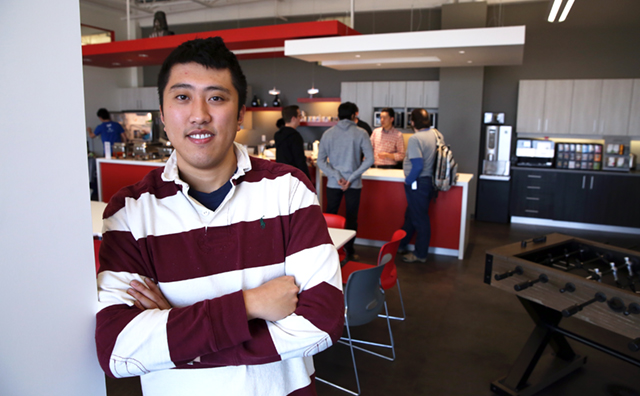
In addition to catered breakfast and lunch, the TextNow kitchen
includes local craft beer on tap. (Communitech photo: Anthony Reinhart)
Q – How many companies do you think raise money because they think they have to, without thinking as critically as you did about whether money was actually the problem?
A – It’s hard to say without knowing everything about every other company.
What I do know is that there’s definitely a lot of over-emphasis on fundraising from media, and I kind of stopped reading it regularly because it was almost brainwashing me that fundraising was an indicator of success.
It’s one indicator of success, but it’s not the only indicator of success. A lot of the press made it seem like it was the only indicator of success, so I could definitely see where it could influence a lot of naïve and young founders to think that’s the only path to success. And then they stop thinking about it a little more, to see if it actually makes sense to them. But I don’t know of any specific examples where that is the case.
Q – There’s a lot of buzz when somebody raises.
A – Another issue is – and I don’t know why – but private companies like sharing their fundraising news but they don’t like sharing their actual metrics that matter.
That also compounds the existing problem. If more private companies were comfortable sharing their actual business metrics, and people started covering that, then we’d get rid of all this bias towards fundraising being what we cover most of the time.
The fact is, a lot of private companies are closed books and they only share their fundraising numbers. If more people shared that, it would lead to more interesting stories.
Q – Speaking of coverage and hype, you’ve been low-key as far as publicity goes. A lot of people locally probably don’t even know you’re here. Is that a byproduct of not having big funding rounds, or is there a deliberate effort to fly under the radar, or do you just see it as not very consequential to your business?
A – I think it’s a bit of everything you’ve said, except for the fact that I wanted to be under the radar. I don’t think there was an explicit intention to be under the radar; we don’t need to be, and I’m pretty transparent and open with everybody.
I don’t go out and try to bring attention to ourselves, but at the same time, I’m not trying to hide anything.
I think that’s just a byproduct of what we have been focusing on, and a lot of what we have been focusing on is our product and how to build an awesome culture internally, and build an awesome team internally.
A lot of our focus has been internal and with our customers, which kind of leads to the byproduct of not getting a lot of coverage, because we don’t sell to businesses; we sell to customers. So we’re always interacting with our customers and not everybody in our community.
But as we grow, we do realize that to be able to recruit the best talent, we have to get out there a bit, and we’re becoming more open-minded to spending more time with media.
Q – Is recruiting becoming harder as you go? We’re always hearing about how tight the talent market is, but has it always been that way, or is it worse than it was a few years ago?
A – I think the market is more competitive now, for sure, but I think that’s a good thing, because that means companies have to step up their game and treat employees better.
I think that’s a great thing for the community.
For us, are we having a challenge finding talent? We’ve made ourselves a lot more competitive with everything. We’ve made sure that there’s room for growth here for employees. They have a lot of autonomy here and they have a lot of opportunities to learn and make an impact on the business.
We have great competitive compensation; we offer stock options; we offer great fringe benefits, like catered breakfast and lunch and an onsite gym; RSP matching, and there’s a bunch of things I’ve probably forgotten to mention.
We’ve done a lot of work to make ourselves competitive, and as a result, maybe we haven’t shared the same challenges. We were able to find great people. But obviously, as we scale, maybe that will get harder, I’m sure.
The dynamic is different when you’re trying to find two engineers versus finding 15 engineers, and you have to find 15 engineers who fit exactly your culture, the skill sets that you want and whatever.
Q – How big is the potential for this company?
A – In terms of the market that we’re going after, I see us just scraping the tip of the iceberg, really.
There are 300 million people in the U.S. and we have a tiny fraction of that, and we’re just going to keep doing what we’re doing. We’re going to make our product better, make our customer satisfaction and retention better, keep recruiting and retaining great employees, and keep growing as a company and keep doing better.
I think we’re really far from the saturation point of the market, and we have no immediate desire to sell or exit the company. So, I think there’s a lot of opportunity, and we’re very optimistic and very excited, every step of the way.
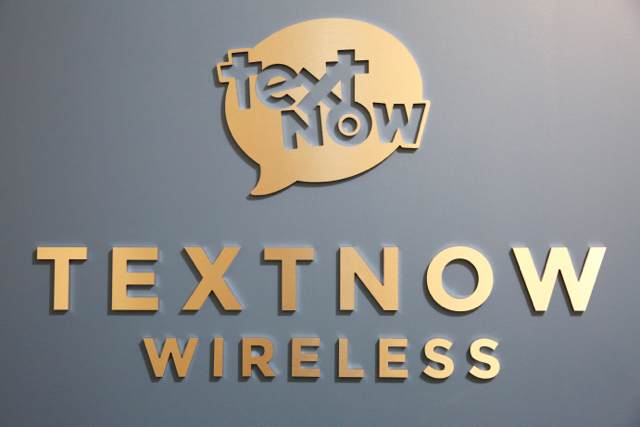
Enflick has been rebranded as TextNow to align with its
core product. (Communitech photo: Anthony Reinhart)
Q – Anything you’d like to add to that?
A – We’re having a great time. No one here really thinks they’re working; they’re just solving really interesting problems and making impact in society and the market, and I think that’s very exciting.
We’re not doing it for the money; we’re not doing it to be rich or to satisfy VCs. We have our own agenda, which I think is very refreshing and very exciting.

